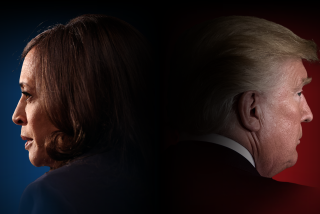$1-Million Visas Seeking to Lure the Wealthy to U.S. : Immigration: It is hoped the rich will open businesses in this country that will provide jobs for Americans.
A century after Lady Liberty proclaimed, “Give me your tired, your poor, your huddled masses,” Uncle Sam is now issuing a new call--this time for the world’s millionaires.
Through a little-heralded provision in the Immigration Act of 1990, the United States is offering well-heeled immigrants the chance to become permanent residents for an investment of $1 million in a business creating at least 10 jobs for Americans.
Up to 10,000 investor visas will be issued annually starting Oct. 1, marking the first time in the country’s history that wealth has become a criterion for legal immigration.
With the start of the program, the United States will join a growing number of countries--from the tiny South Pacific kingdom of Tonga to Canada--that have jumped into the visa-selling business and turned it into a booming global enterprise.
The new law has been wildly cheered by developers, attorneys and government officials who have inundated prospective immigrants with investment options, from million-dollar hamburger stands to experimental bicycle patents.
Even the former commissioner of the Western Region of the U.S. Immigration and Naturalization Service, Harold W. Ezell, has begun selling carwashes and Wienerschnitzel hot dog franchises to the soon-to-be-arriving “yacht people” of the world.
Ezell, a conservative Reagan appointee who made his name through hard-line efforts to curb illegal immigration and his sometimes outlandish stunts to get illegal immigrants to apply for amnesty, started The Ezell Group, his business-immigration consulting firm, in 1981.
He began working full time on his company after his retirement from the INS in 1989 and has been ecstatic over the possibilities of the investor immigrant program. He has held three seminars in Taiwan this year with prospective investors and is planning more in Europe as well as other parts of Asia.
“The possibilities are totally unlimited,” gushed Ezell, whose firm stands to reap thousands of dollars in consulting and service fees for each successful investor immigrant it helps. “This is really long overdue and there’s tremendous interest in this.”
But for some immigration experts, the law also has sounded an unsettling alarm that the selling of U.S. residency is a sign of a small, but potentially significant, shift in American immigration policy.
Arthur C. Helton, an attorney with the New York-based Lawyers Committee for Human Rights, said although the investor immigrant law provides only a tiny number of visas, its adoption marks the emergence of a new ethos of immigration that calls not for the tired, the poor or the huddled masses, but rather, the rich, the skilled and the elite.
“ ‘What’s in it for the United States?’ That’s the question people are asking,” Helton said. “Clearly, we’re making a move in that direction.”
For all the flurry of activity over the investor immigrants, only a few of the world’s wealthy have actually submitted preliminary applications--just 72 so far. Many have come from developed Asian and European countries, such as Taiwan (the leader at 9), Great Britain (5), Japan (4), Hong Kong (2) and Spain (2).
But there also has been a smattering of applications from impoverished and strife-torn nations, including Somalia (1), Bangladesh (1), Iran (1) and even China, where seven applicants somehow managed to strike it rich under Communist rule.
“Yeah, of course there are rich people in China,” said one Los Angeles immigration attorney with frequent contact with Chinese business people. “It’s not easy, but if you’re a party member, it is possible.”
Eugene Chow, a Hong Kong attorney who writes a column on immigration for the colony’s Dong Fang Daily News, said most investors are holding back until the release of final regulations, detailing the types of acceptable investments.
The 1990 Immigration Act contains only a basic outline of the investor program--a minimum $1-million investment in a business employing at least 10 workers. In rural or high unemployment areas, the investment could be as little as $500,000, although tentative regulations have raised the amount back to $1 million.
The INS has been put in charge of reviewing the proposed investments, which must have been made after Nov. 29, 1990, or were in the process of being made.
If the agency verifies the investments, the would-be immigrants and their families would be allowed to enter the country on conditional visas. They would qualify for permanent residency after two years.
Supporters estimate that even with only 10,000 visas a year, the program could bring in more than $8 billion in new investment and 100,000 new jobs each year.
One of the biggest obstacles for the investor program is the stiff global competition for the world’s rich.
Australia, Canada and New Zealand have reaped billions of dollars from Hong Kong residents desperate to leave before the colony reverts to Communist rule in 1997. The visas have been granted for investments of as little as a few hundred thousand dollars.
New Caledonia and Fiji have been wooing foreign investors with $77,000 visas. For the budget-minded, there’s always the island of Tonga, which has visas selling for just $17,500.
The U.S. investor visa is by far the most expensive of the lot, although it is still, for many, the most valued--the “Rolls-Royce of jurisdictions,” Chow said.
Attorneys and business people in the United States are bracing for a flood of applicants. “There are going to be seminars galore pushing hotels and fried chicken places,” Chow said. “For me, it’s very exciting.”
There has been no shortage of activity to mine the mother lode of millionaires around the globe.
Members of the California Commission for Economic Development, a state body created to foster business and job creation, have traveled to Hong Kong and Taiwan with a team of accountants and business experts to attract would-be investors to the Golden State. It has held three investment seminars in California and is planning another three by the end of the year.
“This is one of our top priorities,” said Mary Leslie, executive director of the commission. “We’d be crazy to miss this opportunity.”
Ezell, the former INS official, is one of several business people around the country who have put together packages designed to give each client a green card and a return on his investment in one bundle.
He is banking that his years of experience with the INS will attract investors to his firm.
“There’s millions and millions of dollars out there,” he said. “Let’s bring it to America.”
The shady operators of the world also have jumped on the bandwagon with dubious investment schemes and guaranteed green cards for exorbitant fees. But most immigration attorneys give them little chance of success.
“You’re not going to see much abuse in the million-dollar category,” Chow said. “I mean, these people aren’t stupid.”
Frederick Hong, a Los Angeles immigration attorney, predicted that the number of applicants will climb as the program gets underway and investors begin to sort out the deluge of offers. “The trickle will become a stream and then a flood within the first year,” Hong said. ‘In a year or two, there will be big numbers.”
At best, the number of investor immigrants will be only a small portion of the 700,000 legal immigrants entering the country next year.
But the creation of the program heralds a new emphasis on enhancing the economic benefits of immigration.
Since 1965, legal immigration has been dominated by a policy called family reunification, which gives top priority to the relatives of those who already are permanent residents or citizens.
The policy has been applauded for its humanitarian approach to immigration, but also has been criticized by opponents who say it has burdened the country with an inordinate number of immigrants from developing countries, primarily in Latin America and Asia.
“There is a recognition of the enormous costs of assimilating thousands and thousands of people from the Third World,” said Dave Simcox, director of the Center for Immigration Studies, a conservative Washington think tank. “The national interest has suffered from this massive influx of cheap labor.”
Although the 1990 law preserved family reunification and actually increased the number of family visas from about 463,000 to 520,000 year, it nearly tripled the number of visas based on wealth and job skills from 54,000 to 140,000 a year.
“It manifests a slow, but inexorable modification of policy away from our basic humanitarian approach to immigration,” said Peter Schey, executive director of the National Center for Immigration Rights in Los Angeles. “It sets a terrible precedent. They’re basically saying you can buy your way into the country.”
Supporters of the investor immigrant provision say it only recognizes a hard reality that America can no longer afford an immigration policy dominated by humanitarian concerns.
“It really is a turnaround,” Simcox said. “It’s turning away from this phony egalitarianism and recognizing that immigration can serve a very hard interest of the United States.”
Ezell said he believed that the investor program is only the first step in a re-evaluation of immigration that will eventually lead to a more wealth- and skills-oriented law.
Hong, who played an active role in lobbying for the law as co-chair of the Pacific Leadership Council, a Los Angeles-based organization concerned with Asian-American issues, agreed, saying that the need for the investor program will grow in importance in the future.
Its potential, he said, is only limited by the imaginations of attorneys and business people.
“People should be creative,” he said. “The sky’s the limit.”
Hong said he has begun thinking of ways for investors to jump beyond mere million-dollar hamburger stand investments and join with large corporations, such as General Motors or IBM, in pooled investments involving dozens, perhaps hundreds of foreign investors.
And why, he asked, should investors be limited to just private investment? How about cash-starved public agencies, such as city and state governments?
“I’ve been thinking about the L.A. School District,” Hong said. “Do you think they could use $50 million?”
Applications by Investor Immigrants
Here is a look at the number of people around the world who have submitted preliminary applications to receive investor immigrant visas as of July 18, 1991. Under the new program, certain immigrants would be granted permanent residency in the United States if they invested $1 million in an enterprise employing at least 10 people. The U.S. Immigration and Naturalization Service will begin issuing the visas Oct. 1.
Taiwan: 9
China: 7
England: 5
South Africa: 4
Japan: 4
Israel: 3
Australia: 2
Spain: 2
Philippines: 2
India: 2
Hong Kong: 2
Canada: 2
Switzerland: 1
Somalia: 1
Italy: 1
Malaysia: 1
New Zealand: 1
Mexico: 1
Lebanon: 1
Korea: 1
Denmark: 1
Poland: 1
Iran: 1
Bangladesh: 1
Unknown: 16
TOTAL: 72
SOURCE: U.S. Immigration and Naturalization Service
More to Read
Sign up for Essential California
The most important California stories and recommendations in your inbox every morning.
You may occasionally receive promotional content from the Los Angeles Times.











